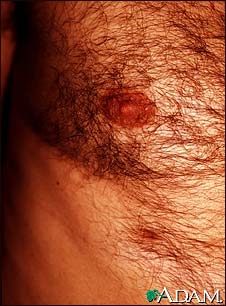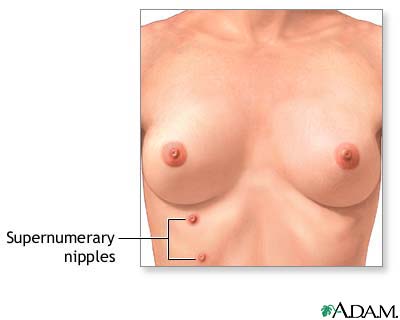Health Library
Supernumerary nipples
Polymastia; Polythelia; Accessory nipples
Supernumerary nipples are the presence of extra nipples.
Images


I Would Like to Learn About:
Considerations
Extra nipples are fairly common. They are generally unrelated to other conditions or syndromes. The extra nipples usually occur in a line below the normal nipples. They are usually not recognized as extra nipples because they tend to be small and not well-formed.
Causes
Common causes of supernumerary nipples are:
- Variation of normal development
- Some rare genetic syndromes may be associated with supernumerary nipples
Home Care
Most people do not need treatment. The extra nipples do NOT develop into breasts at puberty. If you want them removed, the nipples can be removed by surgery.
When to Contact a Medical Professional
Talk to your health care provider if there are extra nipples on an infant. Tell the provider if there are other symptoms.
What to Expect at Your Office Visit
The provider will do a physical exam. The provider may ask questions about the person's medical history. The number and location of extra nipples will be noted.
References
Antaya RJ, Schaffer JV. Developmental anomalies. In: Bolognia JL, Schaffer JV, Cerroni L, eds. Dermatology. 5th ed. Philadelphia, PA: Elsevier; 2024:chap 64.
Bolognia JL, Schaffer JV, Duncan KO, Ko CJ. Developmental anomalies. In: Bolognia JL, Schaffer JV, Duncan KO, Ko CJ, eds. Dermatology Essentials. 2nd ed. Philadelphia, PA: Elsevier; 2022:chap 53.
Conner LN, Merritt DF. Breast concerns. In: Kliegman RM, St. Geme JW, Blum NJ, Shah SS, Tasker RC, Wilson KM, eds. Nelson Textbook of Pediatrics. 21st ed. Philadelphia, PA: Elsevier; 2020:chap 566.
Cugno S, Azzi AJ. Congenital breast anomalies. In: Farhadieh RD, Bulstrode NW, Mehrara BJ, Cugno S, eds. Plastic Surgery: Principles and Practice. Philadelphia, PA: Elsevier; 2022:chap 37.
BACK TO TOPReview Date: 2/17/2024
Reviewed By: Charles I. Schwartz, MD, FAAP, Clinical Assistant Professor of Pediatrics, Perelman School of Medicine at the University of Pennsylvania, General Pediatrician at PennCare for Kids, Phoenixville, PA. Also reviewed by David C. Dugdale, MD, Medical Director, Brenda Conaway, Editorial Director, and the A.D.A.M. Editorial team.
 | A.D.A.M., Inc. is accredited by URAC, for Health Content Provider (www.urac.org). URAC's accreditation program is an independent audit to verify that A.D.A.M. follows rigorous standards of quality and accountability. A.D.A.M. is among the first to achieve this important distinction for online health information and services. Learn more about A.D.A.M.'s editorial policy, editorial process and privacy policy. A.D.A.M. is also a founding member of Hi-Ethics. This site complies with the HONcode standard for trustworthy health information: verify here. |
The information provided herein should not be used during any medical emergency or for the diagnosis or treatment of any medical condition. A licensed medical professional should be consulted for diagnosis and treatment of any and all medical conditions. Links to other sites are provided for information only -- they do not constitute endorsements of those other sites. No warranty of any kind, either expressed or implied, is made as to the accuracy, reliability, timeliness, or correctness of any translations made by a third-party service of the information provided herein into any other language. © 1997- 2025 A.D.A.M., a business unit of Ebix, Inc. Any duplication or distribution of the information contained herein is strictly prohibited.
